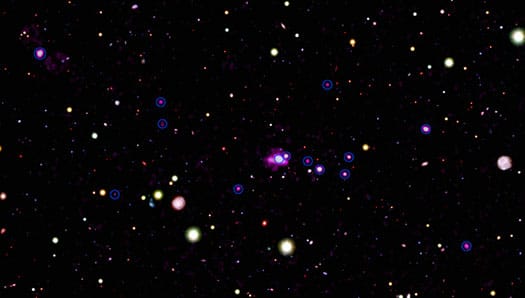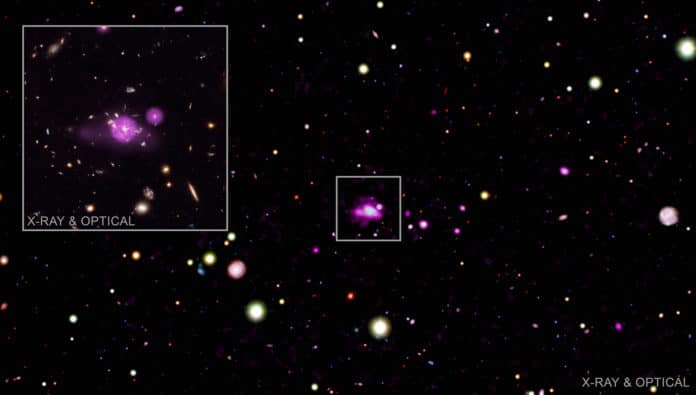NASA’s Chandra X-ray observatory revealed that the objects within the “Spiderweb” protocluster are feasting and growing. After observing the Protocluster over eight days with Chandra, scientists detected signs of 14 actively growing supermassive black holes.
Located about 10.6 billion light-years from Earth, the Spiderweb galaxy is at the center of a protocluster. It is also known as J1140-2629.
Using Chandra, scientists looked for growing black holes in the Spiderweb protocluster. It detected x-rays in the Protocluster (which appears in purple in the main panel of this graphic). The data was then combined with optical data from the Subaru telescope on Mauna Kea in Hawaii (red, green, and white). The resulting image is about 11.3 million light-years across.
The optical image revealed that most of the blobs are galaxies, including 14 detected in the new, deep Chandra image. The x-ray sources signify material falling into the SMBH containing a huge mass.

The 14 sources detected by Chandra indicate that about 25% of the most massive galaxies contain actively growing black holes. This is between five and twenty times higher than the fraction found for other galaxies of a similar age and with about the same range of masses.
Several environmental factors contribute to many rapidly growing black holes in the Spiderweb protocluster. One cause, including a high rate of collisions and interactions between galaxies, is sweeping gas towards the black holes at the center of each galaxy, providing large amounts of material to consume.
Another possibility is that the Protocluster still contains cold gas. The black hole consumes cold gas more easily than hot gas.
Observations by the Hubble could offer detailed insights into a large number of rapidly growing black holes in the Spiderweb protocluster. Extending this work to other protoclusters would also require a sharp X-ray vision of Chandra.
Journal Reference:
- P. Tozzi et al. The 700 ks Chandra Spiderweb Field I: evidence for widespread nuclear activity in the Protocluster. arXiv: 2203.02208/DOI: 10.48550/arXiv.2203.02208
